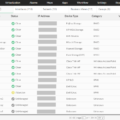Unified Threat Management (UTM) is an essential security tool for businesses of all sizes. UTM systems provide a comprehensive approach to network security, protecting against malicious threats such as viruses, malware, and hackers. By consolidating multiple security functions into one solution, UTM systems are able to detect potential threats faster and respond more quickly to them.
UTM systems use a variety of techniques to protect networks from malicious activity. These include firewall protection, intrusion prevention systems (IPS), antivirus software, web filtering, and application control. Firewalls act as the first line of defense against external threats by blocking unauthorized access to the network. Intrusion prevention systems monitor traffic for suspicious activity and block or alert administrators if something suspicious is detected. Antivirus software scans files on the network for viruses and malware and can be used to clean up any existing infections. Web filtering can be used to restrict access to certain websites or types of content, while application control is used to block applications that are deemed risky or inappropriate.
The benefits of UTM are numerous; they provide greater visibility into potential threats on the network, improved response times when a threat is detected, better control over who has access to company data, and better compliance with industry regulations and standards. UTM solutions also reduce complexity by eliminating the need for purchasing and managing multiple security tools separately – allowing businesses to focus their resources on other areas of IT operations instead.
For businesses looking for an effective solution for protecting their networks from malicious attacks, unified threat management systems provide an excellent option. By providing a comprehensive approach to network security that combines multiple security functions into one solution, UTM solutions are able to offer greater protection from malicious threats with less complexity than traditional methods of network protection – making them an ideal choice for any business looking for reliable network security solutions.

Difference Between UTM and Firewall
UTM (Unified Threat Management) and firewalls are both important tools for protecting a network from various security threats. However, there are some key differences between the two.
UTMs combine several technologies into one appliance, combining firewall, antivirus, intrusion detection/prevention systems, content filtering, and other security features in a single device. This makes them easier to manage and configure than individual components. UTM hardware is larger and more powerful than traditional firewalls, allowing for greater control over data protection and privacy.
Firewalls, on the other hand, focus mostly on managing network traffic through rules that allow or block certain types of activity. They help to protect networks from malicious software or attackers by controlling what packets can go in or out of networks. Firewall rules can be set up on hardware appliances or software products running on servers or computers.
UTM is a more comprehensive security solution that provides multiple layers of protection for networks while traditional firewalls focus mainly on managing network traffic through rules.
The Role of UTM in Firewall Protection
Yes, UTM (Unified Threat Management) is a type of firewall. UTM is a comprehensive security solution that combines multiple security features in a single device or service. It allows organizations to protect their networks from both known and emerging threats by providing advanced firewall capabilities such as web filtering, intrusion prevention, virus scanning, application control, content filtering, and data leak protection. UTM also offers additional benefits such as VPN support and reporting capabilities. By centralizing the management of these features in one location, organizations can simplify their security processes and reduce their overall security costs.
Differences Between UTM and SIEM
UTMs (Unified Threat Management) and SIEMs (Security Information and Event Management) are two popular security solutions that are often used to protect businesses from cyber-attacks. Both solutions offer a wide range of features, but they differ in terms of their approach to data protection.
UTMs are designed with the idea of creating an all-in-one solution for security. They focus on preventing threats by monitoring network traffic, detecting malicious software, and controlling user access. UTM devices also usually include a firewall to provide an additional layer of protection. These systems are typically more affordable and easier to manage than SIEMs, but they don’t offer the same level of logging capabilities or alerting as SIEMs do.
SIEMs, on the other hand, focus more on collecting and analyzing data from various sources to detect potential threats and malicious activities. They can be used to monitor user activity, network traffic, application logs, authentication attempts, etc., allowing organizations to quickly identify suspicious behavior and take appropriate action. SIEMs are also capable of generating alerts when specific events occur or thresholds are exceeded. While SIEMs can be more expensive than UTMs due to their complexity and the need for skilled personnel to operate them properly, they offer greater visibility into an organization’s security posture and enable faster response times in the event of an attack.
The Importance of Unified Threat Management
Unified threat management (UTM) is an important security tool for organizations of all sizes. UTM provides a robust, comprehensive security solution that consolidates multiple security functions into a single platform. This enables businesses to protect their networks and data from cyber threats. UTM solutions can detect and block malicious activity before it reaches the network, monitor traffic in real-time for suspicious activity, control user access to applications and devices, filter web content, and provide detailed log monitoring and reporting. UTM solutions also help reduce the total cost of ownership for IT security by eliminating the need to purchase, deploy and maintain multiple security products. Additionally, UTM solutions are often easier to deploy than traditional firewalls because they can be managed through a single console or web interface.
The Benefits of Utilizing a UTM Firewall
A Unified Threat Management (UTM) firewall is a security system that combines multiple security features into a single platform. UTM firewalls provide comprehensive protection against threats, including viruses, malware, and network intrusions. The main advantages of using a UTM firewall include:
1. Increased Security: UTM firewalls are designed to detect and block malicious traffic before it can enter the network. By leveraging multiple layers of security, such as antivirus scanning, intrusion detection systems, and virtual private networks (VPNs), UTM firewalls help protect your network from malicious activity.
2. Easy Setup and Management: Installing and configuring a traditional firewall can be a complex process requiring expertise in networking protocols and hardware configurations. In contrast, UTM firewalls are much easier to set up and manage because they combine all the necessary security features into one system. This simplifies the setup process and makes it easier for administrators to keep their networks secure.
3. Lower Cost: Since UTM firewalls come with multiple layers of protection already built in, they can help reduce costs compared to buying separate security solutions for each type of threat. Additionally, since UTM firewalls usually require less setup time than traditional firewalls, companies can save money on installation costs as well.
4. Flexibility: One of the main advantages of using a UTM firewall is its flexibility; it’s easy to customize the system to meet your organization’s specific requirements or add additional features if needed. This allows you to tailor your firewall’s settings for maximum protection without having to buy additional products or migrate data to another platform.
Conclusion
In conclusion, Unified Threat Management (UTM) is a powerful security solution that helps protect users from potential threats by consolidating multiple security functions into a single device or service. It provides deeper and more contextual data to detect potential threats quickly and supports rapid response across the entire enterprise environment. UTM systems are especially useful for businesses of all sizes, as they can help reduce the complexity of managing multiple security solutions and provide the most comprehensive protection against emerging cyber threats.








